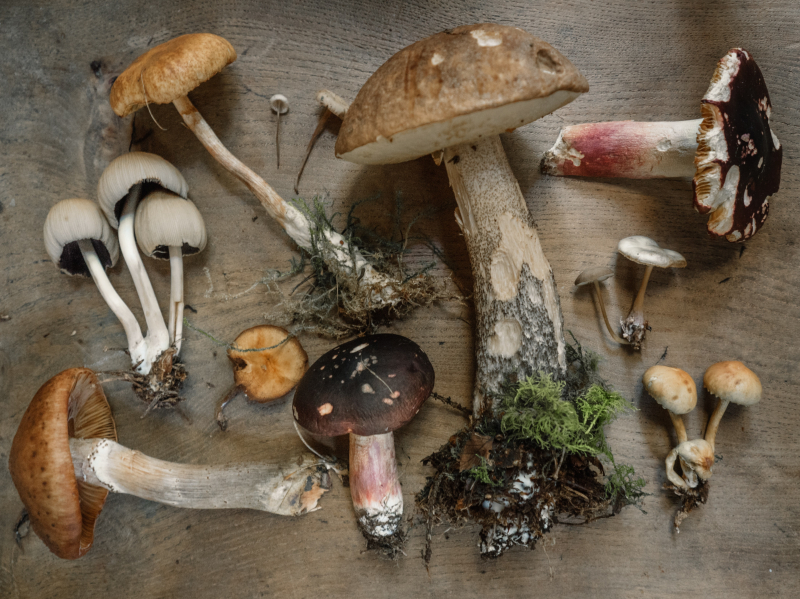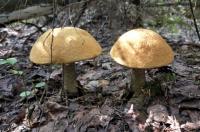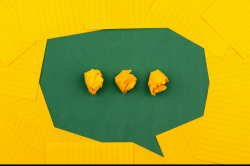As most people who grew up in central Russia, I went mushroom hunting since my early childhood. What’s more, I was once surprised to learn that there are people who know nothing about it, and can’t even discern a porcini from a chanterelle. Still, when they asked me “what’s the point of doing it?”, I couldn’t really say. It just seemed so obvious that I never actually thought about it.
The original intention of gathering mushrooms is quite simple: mushrooms are food, and an important element of traditional Russian cuisine. Mushrooms can be dried, roasted, boiled or pickled; in fact, you can make a delicious dish from mushrooms only, and surely, nothing beats a pickled mushroom as a vodka chaser. Still, many people like meat but you won’t often see them chasing a deer or skinning a pig. So why “hunt” something you can get from a grocery store?
In essence, mushroom hunting is more about adventure than foraging. Few will actually wander in a forest to just appreciate nature’s beauty, don’t you think? Mushroom hunting gives your hike a purpose, and the feeling you get when you find one is most rewarding. You might not believe it, but there are whole communities on social networks where people brag about their finds and post numerous photos - nevermind the flaming about the “proper” mushrooms hunting skills.
Truth be told, you won’t understand the pleasure of mushroom hunting until you actually try it, so here’s some advice to help you make the most of your first mushroom hunting experience!
Dress up and pack right
You’re going to the forest, so dress accordingly. If we are talking about the Leningrad Oblast, most popular mushroom hunting places tend to be quite swampy, so consider putting on rubber boots. Bring a knife to cut the mushrooms (just ripping them out of the ground damages the local mycelium (the underground “root” system of a mushroom bunch), and is frowned upon), and a handy container (preferably a traditional wicker basket and never a plastic bag, unless you want your mushrooms to turn into a sticky, mushy mass that’s totally useless).
Leave early & don’t get lost
Early mornings are the best time to look for mushrooms: they are easier to spot, and the early bird gets the worm. What is more, days are short in autumn, and you wouldn't want to find yourself in the dark while you're still in the forest. Don’t forget to also download the map of the area you’ve decided to go to, as you might experience network connection problems. In case you still get lost, make sure somebody knows where you went, and your smartphone has enough charge.
Know your mushrooms
The Leningrad Oblast is most abundant with various species of mushrooms, and you have to be mindful of what you pick. All of the local mushrooms fall in one of three categories: edible, inedible, and poisonous. While eating an inedible mushroom is just bad for your stomach, the death cap’s name, for instance, speaks for itself. Don’t pick a mushroom if you’re not sure what it is, and consider downloading a mushroom identifying app on your smartphone; though it’s a lot better to bring along a Russian friend who knows these kinds of things. Also, don’t pick mushrooms that grow near roads or railroad tracks, as mushrooms there may absorb dangerous chemicals.
To give you a general idea of what to look for, here’s a short list of the most popular types:
-
Porcini. Called the belyi (white) in Russian, it is the king of mushrooms and the most coveted prize. The amount of porcini that you find is a commonly accepted measure of a mushroom hunt’s success. Still, you should be careful when picking these mushrooms: the poisonous "false" porcini look very much like the real deal.
-
Bolete. Birch boletes and red-capped bolete, you can easily identify them by the gray-white color of their “legs”. Just as with porcini, they are a great ingredient for just any kind of dish.
-
Chanterelle. My personal choice of a mushroom, chanterelles grow in large groups and are very easy to spot. To tell you the truth, I consider my summer spent in vain if hadn’t had my fill of roasted chanterelles!
-
Honey fungi. If it’s not quality, but quantity that you’re after, then honey fungi are your best choice. These mushrooms grow in large groups, often on tree stumps, and you can gather a whole basket without moving around much. Though not as valued as the aforementioned ones, honey fungi are still tasty and easy to cook.
-
Russula. The most common edible mushroom that is really easy to spot, russula have bright caps that can be of different colour (most often red, yellow or gray), and white legs. The name in Russian translates as “eat-them-raw”, but I suggest you don’t do that.
Mushrooms grow in families
If you’ve found a mushroom, look for similar ones in its vicinity. Certain types of mushrooms grow in large groups, and even if the one you found looks old and wormy, there may be fresh ones nearby. Also, when you cut down a mushroom, the mycelium stays, so there’s no point in leaving the smallest ones to grow. In fact, it is the youngest mushrooms that are the most tasty.
Clean the mushrooms as soon as you get home
Mushrooms can be stored for a long time, but you have to prepare them first. Each species of mushroom has a specific preparation procedure, so be prepared for some googling. Slice the mushrooms to dry them or boil them to store in your freezer. Still, fresh mushrooms are the best, and there’s nothing more delicious than a warm bowl of mushroom soup after spending a day in the forest!
Lastly, there’s the most important thing. Remember: mushroom hunting is not about who got the most porcinis, but rather spending a day with your friends and enjoying the beautiful nature. So, we wish you best of luck, and hope that you’ll make great memories of mushroom hunting in Russia!




